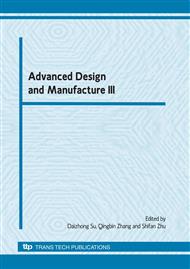p.219
p.223
p.227
p.231
p.235
p.239
p.243
p.247
p.251
Analysis of Heating Steady Temperature Field in an Al1100/Ti-6Al-4V/SiC 2D-FGM Plane Plate by FEM
Abstract:
The steady heat conduction problems under linear temperature load on upper surface in an Al1100/Ti-6Al-4V/SiC 2D-FGM plane plate are analyzed by the FEM. When the variation of the material composition in y-direction is linear, the plane temperature distributions with the changes of composition shape distribution coefficient mx and porosity coefficient Ax in x-direction are obtained. The results show that when mx<0.1, the temperature curve surface is upward convex. The smaller mx is, the bigger relative temperature gradient on the left side of the plate is. When mx>1.0, the temperature curve surface has smaller upward convex trend and becomes downward convex surface gradually with the increasing of the mx (except at =1). The bigger mx is, the bigger relative temperature gradient near the right ceramic side of the plate is. By comparison with the results of an Al1100/SiC 1D-FGM plate, in the 2D-FGM plane plate, when mx=0.5, the maximum value of the temperature difference near metal side increases by 15.6%, but the value near ceramic side reduces by 53%. The temperature curve surface has more obvious variation with the increasing of the Ax in the plate, especially it is when =0.3~0.5 and =0.2~0.5, the changes of the temperature difference value reach the maximum, and compared with Ax=0.0, the value of Ax=3.99 increases by 138.6% at =0.35 and =0.4. The results provide more comprehensive and concrete basis of calculation and the further analysis of thermal stress for the design and optimization of the 2D-FGM plane plate.
Info:
Periodical:
Pages:
235-238
Citation:
Online since:
November 2010
Authors:
Price:
Сopyright:
© 2011 Trans Tech Publications Ltd. All Rights Reserved
Share:
Citation:


